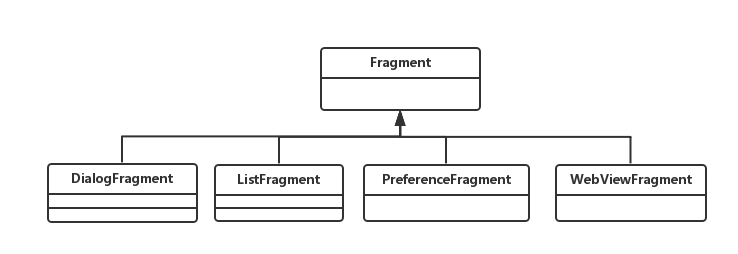一、Fragment概述
Fragment是非常实用的组件,是Android3.0引入的新API,Fragment代表了Activity的子模块,可以将其理解为Activity的片段。
Fragment也拥有自己的生命周期,但它的生命周期会受到它所在Activity的生命周期的控制。例如,当Activity暂停时,该Activity内所有的Fragment都会暂停;当Activity被销毁时,该Activity内所有的Fragment都会被销毁。Android3.0引入Fragment的目的是为了适应大屏幕的平板电脑。Fragment简化了大屏幕UI的设计,不需要开发者管理组件复杂的包含关系。
二、Fragment的作用
开发者使用Fragment对UI组件进行分组,模块化管理,可以更方便的在运行过程中更新Activity的用户界面。
三、Fragment的特征
1.Fragment总是作为Activty的界面组成部分,可以调用getActivity()获取它所在的Activity.而Activity则可调用FragmentManager中方法来获取Fragment。
2.一个Activity可以包含多个Fragment,反之,一个Fragment也可被多个Activity复用。
四、Fragment的创建
与创建Activity类似,创建的Fragment必须继承Fragment基类,android提供了如下图的继承体系:
此外,创建Fragment通常需要实现如下几个方法:
1.onCreate():系统创建Fragment时调用此方法,在方法中初始化在Fragment中的必要组件。
2.onCreateView()当Fragment绘制界面组件会回调此方法,此方法返回一个View对象,也就是Fragment所显示的View
3.onPause() 当用户离开Fragment时调用此方法
下面介绍一个Fragment显示加载一份简单的界面布局文件,并根据传入的参数更新界面组件的程序实现。
代码如下:
public class BookDetailFragment extends Fragment
{
public static final String ITEM_ID = "item_id";
// 保存该Fragment显示的Book对象
BookContent.Book book;
@Override
public void onCreate(Bundle savedInstanceState)
{
super.onCreate(savedInstanceState);
// 如果启动该Fragment时包含了ITEM_ID参数
if (getArguments().containsKey(ITEM_ID))
{
book = BookContent.ITEM_MAP.get(getArguments()
.getInt(ITEM_ID)); //①
}
}
// 重写该方法,该方法返回的View将作为Fragment显示的组件
@Override
public View onCreateView(LayoutInflater inflater
, ViewGroup container, Bundle savedInstanceState)
{
// 加载/res/layout/目录下的fragment_book_detail.xml布局文件
View rootView = inflater.inflate(R.layout.fragment_book_detail,
container, false);
if (book != null)
{
// 让book_title文本框显示book对象的title属性
((TextView) rootView.findViewById(R.id.book_title))
.setText(book.title);
// 让book_desc文本框显示book对象的desc属性
((TextView) rootView.findViewById(R.id.book_desc))
.setText(book.desc);
}
return rootView;
}
}上述Fragment用来显示一个简单的布局文件,界面内容由布局文件定义。
五、Fragment与Activity的交互
创建完Fragment后,为了让它在Activity中显示,则必须将Fragment加载到Activity中,将Fragment加载到Activity中有如下几种方式:
(1).在布局文件中添加Fragment ,元素的android:name属性指定为Fragment的实现类。
(2).在类中通过FragmentTransaction对象的add()方法添加Fragment。如getFragmentManager()可返回FragmentManager,而FragmentManager对象的beginTransaction()可开启并返回FragmentTransaction对象。
实例如下:
1.Activity会通过布局文件使用定义好的BookDetailFragment ,此Activity的左边显示一个ListFragment,右边会显示一个Fragment容器,该容器会动态更新Fragment显示的内容。
<?xml version="1.0" encoding="utf-8"?>
<!-- 定义一个水平排列的LinearLayout,并指定使用中等分隔条 -->
<LinearLayout
xmlns:android="http://schemas.android.com/apk/res/android"
android:orientation="horizontal"
android:layout_width="match_parent"
android:layout_height="match_parent"
android:layout_marginLeft="16dp"
android:layout_marginRight="16dp"
android:divider="?android:attr/dividerHorizontal"
android:showDividers="middle">
<!-- 添加一个Fragment -->
<fragment
android:name="org.crazyit.app.BookListFragment"
android:id="@+id/book_list"
android:layout_width="0dp"
android:layout_height="match_parent"
android:layout_weight="1" />
<!-- 添加一个FrameLayout容器 -->
<FrameLayout
android:id="@+id/book_detail_container"
android:layout_width="0dp"
android:layout_height="match_parent"
android:layout_weight="3" />
</LinearLayout>2.Activity代码:
public class SelectBookActivity extends Activity implements
BookListFragment.Callbacks
{
@Override
public void onCreate(Bundle savedInstanceState)
{
super.onCreate(savedInstanceState);
// 加载/res/layout目录下的activity_book_twopane.xml布局文件
setContentView(R.layout.activity_book_twopane);
}
// 实现Callbacks接口必须实现的方法
@Override
public void onItemSelected(Integer id)
{
// 创建Bundle,准备向Fragment传入参数
Bundle arguments = new Bundle();
arguments.putInt(BookDetailFragment.ITEM_ID, id);
// 创建BookDetailFragment对象
BookDetailFragment fragment = new BookDetailFragment();
// 向Fragment传入参数
fragment.setArguments(arguments);
// 使用fragment替换book_detail_container容器当前显示的Fragment
getFragmentManager().beginTransaction()
.replace(R.id.book_detail_container, fragment)
.commit(); //①
}
}由此可见,将Fragment添加到Activity后,Fragment必须与Activiity交互信息,则可按如下方法进行
1.调用Fragment下的getActivity()获取它所在的Activity。
2.调用Activity关联的FragmentManager的findFragmentById(int id)获取指定的Fragment。
此外,Fragment还可以与Activity进行数据传递,比如:
1.Fragment向Activity传递数据:则在Fragment中定义一个内部回调接口。
2.Activity向Fragment传递数据:则在Activity中创建数据包Bundle 后调用Fragment的setArguments(Bundle bundle)方法可将Bundle中的数据传给Fragment。























 653
653











 被折叠的 条评论
为什么被折叠?
被折叠的 条评论
为什么被折叠?








